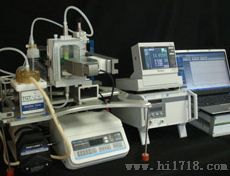-
图文详情
-
产品属性
-
相关推荐
心脏瓣膜生理间歇性流体剪切应力压力机械模拟3D体外组织工程构建生物反应器 CardioGen
The DynaGen® Series bioreactors provide mechanical stimulation to threedimensional tissue engineered constructs to create physiological conditionsin-vitro. The CardioGen system imparts pulsatile flow and pressure to a valveor valve-like structure. Applications include the investigation of cellfunction and differentiation, pharmaceutical benchtop testing, and the seedingand growth of engineered tissues and medical devices.
Chambers
The CardioGen bioreactor chamber accommodates pulsatile and shear stressstimulation for a single valve construct. Standard construct sizes may rangefrom 9 to 21 mm inner diameter and from 50 to 80 mm long. Grip placement canaccommodate both pulmonary valves with straight downstream vessels and aorticvalves with angled downstream vessels. The modular design facilitates scaffoldinstallation and cell seeding separate from the stimulation system. Multipleports are available for media access, catheter probe insertion, samplecollection, or further instrumentation. The autoclavable chamber has a volumeof 430 mL. Additional chamber features include:
| | | |
| Design: | | Polycarbonate hinged windows for easy viewing and laser micrometer measurement |
| Size: | | 145mm(5.7”)L x 105mm(4.15”)W x 74mm(2.9”)D |
| Ports: | | 6 |
Grip Options
CardioGen chambers use barbed stainless steel fittings and either sutures orclamps to fix the construct in place. Standard barb sizes range in size from 9to 21 mm and are interchangeable using a universal connector system.
DynaGen® Stimulator:
The CardioGen bioreactor system includes the 6Vr pulsatile pressure mechanicalstimulator. The 6Vr stimulator features a 40N linear motor that is compact,corrosion resistant and incubator compatible. The stimulator employs pressurecontrol to deliver user defined sinusoidal or physiological pressure waveformsto a maximum pressure of 200 mmHg. The 6Vr is integrated with a computercontrolled mean flow pump and is capable of low or high-flow configurations.The flow rate of the mean flow pump is automatically altered to maintain thedesired mean pressure within the heart valve. The stimulator dimensions are asfollows:
| | | |
| Size: | | 152mm(6.0”)H x 102mm(4.0”)W x 102mm(4.0”)D |
| Weight: | | 2.1kg (4.6lb) |
GrowthWorks® Software & Control:
A fifth generation design, the GrowthWorks Software and Control platformincludes advanced capabilities, such as multiple waveform control, dataacquisition and multi-motor operation. The intuitive software runs on aWindows® laptop computer and features a simple user interface. User definedstimulation profiles are controlled by the software and are readily monitoredusing graphical displays. Integrated data acquisition routines capture andrecord data at user prescribed intervals. The GrowthWorks Software isconfigurable for running four stimulators while simultaneously monitoring up to16 transducers, allowing the researcher maximum flexibility.
The GrowthWorks Control Hardware features an embedded Intel CPU,integrated data acquisition and integrated motor drives. Communications betweenthe laptop and control hardware is transmitted over a standard network cable.Primary advantages of the TGT Laptop/Controller approach are reduced physicalsize and easy upgradability. As future Windows versions or higher performanceLaptops become available, either can be replaced without any software orcontroller changes. This ensures the GrowthWorks control system will be an integralpart of your research for many years to come.
GrowthWorks Stiffness Measurement & AnalysisSoftware:
The GrowthApps modules provided added capability to GrowthWorks. The additionof the Stiffness Measurement & Adaptive Control Application enables thesystem to make real-time measurements of the sample stiffness during culture.Described inU.S. Patent 7,410,792 B2 Instrumentedbioreactor with material property measurement capability and process-basedadjustment for conditioning tissue engineered medical products., the Application measures the mechanical response of the tissue constructas it is being stimulated and conditioned. The stiffness measurements can beused as guidelines for bench marking progress during culturing or for modifyingthe stimulation profile. Based upon the measured response, the bioreactorsystem is then capable of altering the stimulation profile. This technologyenables researchers to automatically culture the tendon or ligament frominitial seeding to an implantation-ready state with minimal operatorintervention.

